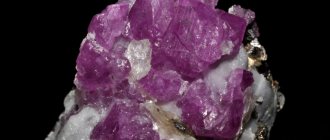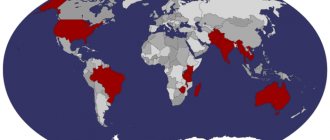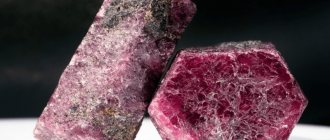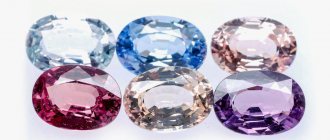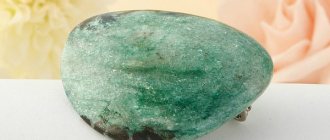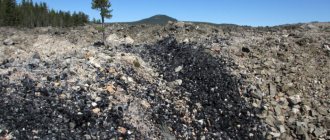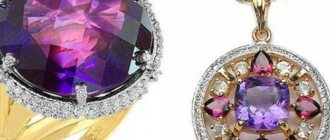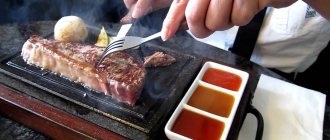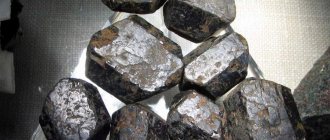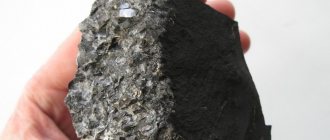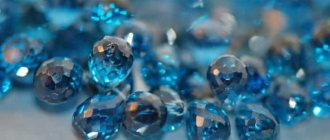Minerals synthesized in production have the same properties as natural corundum, and the quality is even better than the original. When used correctly, artificial crystals look ideal in jewelry and become magical assistants and healers for their owner.
Is the mineral corundum precious?
Almost all ladies love jewelry adorned with bright sapphires and rubies.
Many people know that these gems are precious and are classified as first category stones. But not everyone knows that these same crystals belong to one group of minerals, the general name of which is corundum. Therefore, the answer to the question of whether corundum is a precious stone or not can only be answered positively. Sapphires and rubies have their own precious varieties:
Rubies are a mineral with a transparent structure, their colors range from bright, rich scarlet and cherry to pale and pinkish red. These gems have the following subspecies:
- Star-shaped;
- Siamese;
- Ceylonese.
Sapphires are nuggets that also have a transparent structure; their color range has bright cornflower blue shades, as well as lighter colors. These minerals are divided into:
- Star-shaped;
- Leucosapphires;
- Violet (oriental amethyst);
- Padparadscha;
- Chlorosapphire.
A fairly wide range of colors of stones is explained by various impurities in their chemical composition; as a rule, iron, manganese, titanium and chromium contribute to unusual colors.
Description of the stone
Corundums are a group of minerals. They have similar not only physical, but also chemical properties and structure. Some time ago it was believed that different species derived from corundum belonged to independent materials. But then chemistry and geology developed rapidly. And it became known that all minerals related to the same group are simply varieties of corundum.
How did the name of the stone come about? There is an assumption that the name comes from the words “kauruntaka” and “kuruvinda”, which are translated from Sanskrit as ruby.
But there is corundum without impurities, pure. The stone is very rare, so its value is high all over the world; the pleasure of wearing such a stone in jewelry is not cheap. A feature of pure corundum is its complete transparency, it has no color, and has a glassy luster. Outwardly it looks like a diamond.
The most commonly mined corundums are colored corundums due to the fact that they contain colloids that give them color. There are a wide variety of shades: blue, blue, green, scarlet, lilac. Since ancient times, red corundums have been valued as they are associated with power.
Main characteristics: physical properties, colors and chemical composition
The largest percentage of corundum is aluminum oxide. It also contains impurities of iron, magnesium, nickel, titanium and vanadium in varying proportions. Industrial corundum contains more iron, red carbuncles have more chromium, and dark blue sapphires have more titanium. Bright, pronounced shades can be achieved by technical means: irradiation or heating. These methods are often used in the production of synthetic stones.
Pure corundum is characterized by a high degree of hardness and transparency with a glassy luster. Its hardness on the Moss scale is 9 points, and the density of the mineral varies from 3.95 to 4.1 s/cm³. The melting point of the mineral is over 2030°C. The crystal is insoluble in chemical acids.
The most famous varieties of corundum are sapphires and rubies. The latter often compete in price with pure diamonds. The color range of rubies varies from dark pink to cherry red. The most expensive stones are burgundy.
There are several types of rubies:
- Star-shaped. Rare minerals. The origin of the name is closely related to their appearance. The main feature is the star, which is clearly visible on the cut of the crystal.
- Ceylonese. Rubies of an unusual shade - lilac and purple. The main place of production is Sri Lanka.
- Siamese. Thai stones are also distinguished by their unusual color and high degree of purity.
- Burmese. Natural stones “pigeon blood color”. They have the brightest fluorescent red color, which is noticeable regardless of lighting.
- Tanzanian. Rubies of the darkest shade of the guarantor. The stones mined in Songea are considered the purest in the world.
The second precious variety is sapphires. The main shade can vary from pale bluish to dark cornflower blue. A wide color spectrum provides a variety of types:
- Chlorosapphires. Green colored minerals that are often confused with emerald.
- Padparadscha. Translated from Sanskrit “lotus flower”. Stones in pink, orange and yellow shades.
- Leucosapphires. The second name is “oriental diamonds”. The main difference is the lack of color, transparency.
- Star-shaped. Crystals with the same asterism effect as rubies (a star on the cut).
- Blue. One of the rarest sapphires, distinguished by a delicate cold hue. Mined in India and Australia.
- Blue. Kashmiri stones with the purest shade of “royal” blue are considered the best in the world. Australian sapphires are characterized by a black-blue tone, while Ural sapphires are characterized by a gray-blue color.
- Alexandrite. Unique minerals that, like alexandrite, can change their color depending on the lighting.
It is also worth mentioning emery - an industrial type of corundum, which, mixed with magnetite, is used as an abrasive material.
Do you like the varieties of corundum stone? Very Not particularly
Korunda Group
A group of minerals called corundum is not found in nature as often as connoisseurs and collectors of precious stones would like. And this is not surprising. After all, they include some of the most majestic gems present on Earth. A red specimen is called a ruby, while blue and cyan shades are called sapphire. There are a great many legends about these unique nuggets; historical facts confirm that corundums were in price even during the existence of the ancient world. What are these stones? What is their composition, crystal structure, where are the main deposits located? All this will be discussed below.
Chemical composition and crystal lattice of corundum
When studying the mineral at the molecular level, you can see that it is based on aluminum oxide. The chemical formula of any corundum is as follows - Al₂O₃. Almost always it contains additional substances: iron, chromium, titanium and others. However, their concentration is negligible and occupies no more than two percent of the total mass. The presence of certain chemical elements affects the color of the nugget, each of which has its own name. So, the following types of stones are distinguished:
- Ruby is a red stone, belongs to the group of precious nuggets;
- Sapphire - predominantly blue and blue specimens, are also considered a precious mineral, but are valued less than rubies;
- Padparadscha belongs to the group of fancy sapphires. The mineral has a yellow or orange color, which is possible due to iron impurities.
- Star corundum is an amazing nugget, on the surface of which you can see a shining six-pointed star. It comes in red or blue color.
- Leucosapphire is the second name for “oriental diamond”; it is a transparent mineral that is of little value;
- Common corundum is the most commonly found in nature. It is gray in color and opaque. It has physical properties similar to precious specimens - strength, fire resistance. Therefore, it is often used as an abrasive and refractory material, as well as in the production of certain types of enamel.
If you study the crystal lattice of corundum, you can see that the oxygen particles (highlighted in red in the figure) are located very tightly to each other. In this case, groups of three oxygen ions are always in contact with two aluminum particles (indicated by gray spheres in the figure). This martensitic transformation of the metal provides a very strong interweaving, due to which the crystals have a high hardness index, second only to diamonds.
The period of crystallization of aluminum oxide under natural conditions requires a huge amount of time, estimated in hundreds of years. It is important to observe the external conditions due to which the stone is formed.
According to geological studies, aluminum ranks third in its presence in the earth's crust and is second only to oxygen and silicon. The total share of aluminum is about 7%. But the proportion of corundum is much less. For its formation, many factors and environmental influences are necessary. There is still no accurate data on the amount of this mineral in the earth.
Crystal Shape
There is no exact date for the official discovery of the group of minerals. It is reliably known that it was mined back in the days of Ancient Rome and Ancient Greece. Even then, scientists used its density to create tools and its incredible beauty in the production of jewelry. But the unification of all corundums into a common group took place only in the 19th century.
The appearance of the crystals has a pyramidal, barrel-shaped or columnar shape. Moreover, the size of each individual sample can reach 10 centimeters in diameter. Most often in nature, corundum is found in the form of inclusions in another rock. And getting a whole, undeformed specimen is quite a difficult task. The described nugget never forms in geodes.
Crystallographic characteristics
syngony L33L23PC.
The class is ditrigonal-scalenohedral.
Crystal structure
Al atoms are located in the octahedral voids of the hexagonal closest packing of O atoms according to the “corundum” motif
- Al atoms fill 2/3 of the octahedral voids). The octahedral layers are superimposed on one another in such a way that there are columns of octahedra elongated along the c axis.
- two filled octahedra alternate with unfilled ones.
It is the only natural modification of alumina. The structure corresponds to artificial α-Al2O3. Among artificial compounds, a number of unstable modifications of Al2O3 have been identified, resulting from heating gibbsite, bayerite and boehmite and representing intermediate products in the transition of trihydrates and boehmite to corundum (α -Al2O3).
Main forms : c (0001), r (1011), n (2243), a (1120) (corresponding to the flat faces of F, according to Hartmann), also z (2241).
Physical properties of corundum
Optical
Color varied; the most common is bluish or yellowish-gray (for opaque and translucent varieties); also white to colorless, yellow, violet, red, green, indigo blue, brown, black. Sometimes in daylight blue or green becomes reddish, purple in artificial light; in some cases, blue corundums darken under artificial light. Color is one of the main characteristics by which corundum varieties are distinguished. Crystals with zonal coloring with alternating zones of red, blue or other colors are known; zones parallel to the prism and pyramid were noted. Based on the study of artificial crystals, it was established that in the absence of impurities, corundum is colorless. The admixture of Cr gives corundum a violet-red color, Ni - yellow, V - greenish-gray, Ti and Fe - violet-blue, V and Cr - violet-pink, similar to the color of amethyst.
- Trait . The color of the powder is white.
- The luster is diamond to glassy, sometimes pearlescent on (0001).
- Transparency Usually translucent only in thin fragments; precious varieties are transparent.
Refractive indices
Nm = 1.767 and Np = 1.759.
Mechanical
- Hardness 9. Microhardness 2108 kg/mm2; In artificial corundum rolls, the microhardness is the lowest on the basopinacoid.
- It is fragile and very viscous in fine-grained masses.
- The degree of wear of corundum (sapphire, ruby) is different on different faces and significantly depends on the direction.
- Density. 3.95—4.4
- There is no cleavage; The separation by (0001) and (1011) is sometimes good, and occasionally by the prism.
- The fracture is uneven to conchoidal.
- It splits quite easily along individual planes.
The largest factories for the production of electrocorundum
Factories for the production or production of electrocorundum are located in the central part of Russia. We have prepared for you a list of factories from Russia so that you can work directly and easily buy electrocorundum in bulk
Artificial corundum containing aluminum oxide
Manufacturer Reinforced millstones
Suppliers Non-reinforced millstones
Largest millstone manufacturers
Exporters Artificial corundum with aluminum oxide content less than
Millstone manufacturing companies
Production of refractory cements
Manufacturer Sand or steam blasting machines and similar projectile devices
Fire bricks suppliers
Largest manufacturers Natural or artificial abrasive powder or grain only on woven textile backing
Millstone exporters
Corundum deposits and mining
There are several types of deposits of corundum group minerals:
- Igneous deposits - similar corundum formations in the earth's crust have not been fully studied. However, it is precisely this rock that is characterized by deposits of precious sapphires. Such deposits include Thailand and the USA.
- Pegmatite – Alkaline rock often produces pegmatites, a type of durable stone. Sometimes small inclusions of corundum can be found inside it. These deposits are typical for Canada, South Africa and part of Russia (Ilmen Mountains).
- Skarn – rubies and sapphires are most often found here. The most famous deposit is in Burma.
- Hydrothermal - the thermo-chemical reaction that occurs in this case forms corundum mica, which is not used for jewelry purposes. However, ruby mica is highly prized by collectors. Similar formations have been found in Kazakhstan, Tanzania and Russia.
- Placer – placers of minerals are sometimes found near the above deposits.
- Metamorphogenic - marble and limestone have a sinter type of formation. It is here that clusters of rubies are also found. In Russia, similar deposits are located in the Krasnoyarsk Territory.
In the Middle Ages, the only deposit of precious corundum was considered to be Southeast Asia - India, Thailand, Burma. Today, stones are mined in Canada, the USA, on the island of Madagascar and other countries. In Russia, nuggets are also present, but their reserves are much smaller than in other countries.
The most famous gem mines on Russian territory are the Ural Mountains. This is the ideal location for most minerals that form in the voids. However, corundums are not such gems.
Related corundum species
Often in nature there are amazing specimens of nuggets fused together. It is especially common to see needle-like types of crystals inside a larger mineral. Such samples are especially valued among jewelers and gem connoisseurs. Unprocessed corundum is usually found not separately in the form of a scattering of gems, but inside some solid parent rock. This can be feldspar, quartz, andalusite, rutile, spinel, mica and even regular granite, as shown in the photo.
In order not to lose precious carats, specialists carefully extract the valuable rock, trying not to greatly destroy the mountain range.
The most common corundum
We can safely say that the most famous and most expensive corundum in the world is the deep red ruby. Blue sapphires are not far behind in importance and value. It’s hard to say which type of mineral group our Earth is richest in. After all, the search is mainly carried out exclusively for precious stones; all other types of nuggets are not of much interest to the mining industry. That is why the most common corundums are the above rubies and sapphires.
Main varieties of corundum
- 1. Sapphire. Their value is slightly lower than rubies. But in appearance they are as beautiful as rubies, and their physical properties are in no way inferior to their competitors. But buyers more often choose red rubies than blue sapphires. Sapphires come with a blue or blue tint. The darker the color, the more expensive the price of the stone. Cornflower blue is considered one of the most expensive shades. It is mined on the island of Ceylon. Sapphire is perfectly transparent and rich in color. If the color is darker or lighter than cornflower blue, then the price is already reduced.
- 2. Ruby. This is red corundum. Since the shade of the stone depends on the chemical composition, that is, on the impurities that it contains, pure ruby is extremely rare in nature; its shades can be very different. It contains chromium oxide, which gives it a rich scarlet hue. The mineral is transparent, the shade can be very saturated and less saturated. The most expensive shade is dark cherry. The stone is so valuable that it is more expensive than diamonds, and some pieces are more expensive than diamonds. If red corundum has a brownish tint, then its value decreases. Therefore, a color such as “ruby” can imply shades from red to blue.
- 3. Gray corundum. The mineral is translucent and has a blue tint.
- 4. Leucosapphire. Corundum is transparent and resembles diamond in appearance.
- 5. Yellow corundum. Another name for the mineral is padparadscha. These stones come in orange and yellow shades. This happens thanks to the iron in their composition. If the composition contains nickel, due to which the stone received a yellow color, then it is called yellow sapphire.
- 6. Alexandrite. This stone is natural, its cost is high. A synthetic mineral is often produced based on synthetic corundum, to which vanadium is added. The result is a nice pebble, but it does not have any special properties - healing or magical. The artificial stone is best called corundum, which has the effect of alexandrite.
- 7. Oriental emerald. Green corundum. Outwardly, it looks like an emerald, which is why it is called that.
- 8. Pink stone. It contains manganese, which is why the stone has a pink color.
Corundums come in a variety of colors. Pure corundums are rarely found. Green crystals are even rarer, but it is more layered, as it has alternating yellow and blue layers, which when exposed to light gives a distinct green tint.
If the corundum is natural, relatively large and transparent, of course it will be highly valued, since such a specimen is rare. Synthetic corundum is produced in hundreds of kilograms, so it has no special value.
Rubies
Ruby, or red yakhont, is a type of stone with a scarlet color, which is given by impurities of chromium. Transparent rocks are more valuable than diamonds. Burmese rubies are considered the most expensive. They have a rich, deep scarlet hue with a bluish tint - the color of pigeon's blood. Thai stones are distinguished by a light brownish tone - Siamese. Rubies from Sri Lanka are scarlet with a bright crimson tint, and Vietnamese ones are purple.
There is a special type of red yacht with an asterism effect. In another way, this mineral is called star ruby. When light hits the stone, it creates the effect of a star shining inside.
The category of rubies includes primarily stones of a bright red hue.
Sapphires
Sapphire, or azure yakhont, is a precious blue or light blue corundum, colored with titanium atoms. The richest cornflower blue stones from India - Kashmiri - are considered the most valuable. Siamese minerals from Thailand have a greenish tint. Sapphires from Sri Lanka (Ceylon) are light blue with a bluish tint.
In Tanzania, unique stones are mined that change their color depending on the lighting (the so-called alexandrite effect). Shining asterias (star sapphires) and minerals with a cat's eye effect are especially valued by jewelers.
Sapphire is a precious stone that is cheaper than ruby.
Other types
In addition to the familiar rubies and sapphires, there are other types of corundum:
- Padparadscha , which is translated from Sinhala as “lotus color”, is a stone that has an orange-pink color. The iridescence of its shades is poetically called “the color of the sunset tropical sky” or “molten gold.” But this species is valued not only because of its color. Compared to ruby, the mineral is more transparent and has fewer defects. It is believed that real padparadscha is found only in Sri Lanka.
- Green corundums are oriental emeralds, or chlorosapphires, less valuable stones of deep color, sometimes with a yellowish tint.
- Violet - oriental amethysts, iridescent in shades from pink to dark lilac.
- Polychrome sapphires are rare yellow-green, violet-blue or, for example, blue-green corundum. In the structure of the stone, 2 dissimilar colors are visible, which is due to impurities in the rock.
- Leucosapphires , or oriental diamonds, are the rarest varieties. Transparent, with a metallic or glassy sheen, without any color. They are especially highly valued among jewelers because of their uniqueness.
- Emery , or technical muddy corundum, has no jewelry value. Due to its hardness it is used as an abrasive. It can be either white or brown. The first one is looser, but at the same time it is a pure abrasive - it contains 99% Al2O3.
In nature, not only blue and red, but also other varieties of corundum are found.
VIRTUAL MUSEUM
Synthetic corundum is a single crystal of aluminum oxide, painted in different colors. People often ask: “What color are artificial corundums?” So, synthetic corundum imitates almost all precious stones. Thus, the Korund enterprise in the city of Dzerzhinsk, for example, offers corundums of completely different colors, including red (ruby colors), light blue, blue and dark blue (sapphire colors), alexandrite corundums, light, dark and purple amethyst corundums . Light yellow, yellow and orange-yellow topaz corundums are also offered.
For example, in the photo below - Soviet-made pink corundum
The padparadscha (padparadshah) corundums stand apart - these are bright pinkish-orange corundums. Note that the word "padparadshah" (padparadshah), denoting the pink-orange color of corundum, is a corruption of the Sinhalese word padmaragaya (lotus color).
There is also “demburite corundum” (dark yellow). In addition, synthetic light green corundum is available.
The photo below shows red (and even more likely crimson) ruby artificial Soviet corundum (photo taken using a USB microscope with 200x magnification). Pay attention to the stripes, these are traces of cutting made by a cutting machine
This is what a ring with this dark red stone looks like.
Synthetic corundum is mainly aluminum oxide Al2O3. A melt is made, which is then crystallized (complete crystallization of an industrial melt takes about a week). At the beginning of crystallization, the crystal is colorless, but then it turns slightly pink. In order to change the color of artificial corundum, there are various methods. So, if you shine an ultraviolet lamp on pinkish corundum, you will get a wine-brownish corundum color (see example in the photo below). You can also achieve a brown color by adding iron (note that this brown color is similar to rust).
Adding some chromium ions will give you a red color (like ruby), adding manganese will give you a pink color, and vanadium will give you a green color in natural light and purple in artificial light (artificial alexandrite). The addition of nickel gives a yellow color (a la yellow topaz), and titanium gives a purple-pink color (amethyst). The blue color is obtained by adding 1.5% iron oxide and 0.5% chromium oxide
Here, for example, is synthetic Soviet amethyst corundum under a microscope.
Here it is in the product. Differences in color in photos are caused by different lighting: the top photo was taken with a USB microscope with illumination, the photo below was taken under natural light outside.
The first synthetic corundum (it was a ruby) was created in 1837. In 1847, the first synthetic blue corundum (artificial sapphire) was produced. But for the first time, a stone suitable for cutting into jewelry was obtained only in 1877. The possibility of industrial production of synthetic corundum was first discussed in 1903. Things took off: in 1907, the global annual production of synthetic rubies reached 5 million carats.
In Russia, the first industrial artificial corundum was produced in 1939. This task was mainly dealt with by the Institute of Crystallography of the Russian Academy of Sciences. A.V. Shubnikova. In 1947, an industrial method and equipment for crystallizing synthetic ruby in the form of rods was developed there. In 1950 A.V. Shubnikov and S.K. Popov was awarded the State Prize for developing methods for growing corundum crystals and organizing their industrial production. In general, in the USSR the following equipment was used for growing crystals: KPC, Diakont, Sapphire-2U, Sapphire-3, Granat-3 and Sapphire-2MG.
There is an opinion that synthetic corundum became very popular in jewelry in the USSR in the 70-80s. But this happened earlier. Thus, Chernorechensky already in the 50s of the 20th century obtained the first crystals of dark red ruby and developed technologies for the production of alexandrites, sapphires, amethysts and topazes for the jewelry industry.
As for the question “is it possible to distinguish synthetic rubies and sapphires from real ones”, it is not difficult to answer. In the USSR, the vast majority of rubies, sapphires, tourmalines and other large transparent cut stones were synthetic. There is especially little chance of a natural stone when it comes to silver. In the USSR, synthetic corundum was neither rare nor expensive: the cost of one stone, including cutting, was about 3 rubles 20 kopecks.
And yet, there are methods that allow you to distinguish artificial corundum from real gemstones with 100% confidence. Thus, natural and artificial crystals have different absorption spectra. For such studies, a gemological spectrometer is used.
There is another method: the so-called immersion method. The crystal to be examined is placed in a special liquid that makes it completely transparent. This liquid is different for different minerals. Now the stone can be examined by studying its internal structure under a microscope, and especially carefully the inclusions. Thus, in natural rubies of Burma, crystals of spinel and apatite are found, and in rubies of Sri Lanka - zircon, garnets, pyrite... Also, Burmese rubies are characterized by an uneven distribution of color. Natural sapphires also have their own peculiarities: there is an abundance of gas-liquid inclusions that form patterns reminiscent of honeycombs, grids and fingerprints. Synthetic corundums are distinguished by gas inclusions that are round, oval, elongated or spindle-shaped), single and forming clusters. Solid inclusions in synthetic corundum can be represented by “non-melting”.
Even a regular microscope is suitable for searching for inclusions (or lack thereof). The photo below shows inclusions in natural amethyst under a microscope.
Also, some synthetic stones glow differently in ultraviolet rays than natural ones (for example, alexandrite-like synthetic corundum).
Natural corundums
The color of natural corundums is also due to impurities that replace aluminum. The admixture of chromium gives the ruby a violet-red color; the brightness of the color depends on the amount of chromium: in bright red crystals there is 2-4%, in pale pink crystals - tenths of a percent. The admixture of titanium gives a blue color (sapphire), iron - yellow (padparadscha), iron and manganese - brown and pink. Sometimes zonally colored crystals of natural corundum are found, where alternating stripes are observed. For example, lilac and violet. Completely colorless corundum crystals have not yet been found in nature.
The name of the mineral comes from the Sanskrit word Kuruwinda - ruby. In the Middle Ages, pink ruby was called a carbuncle. Until the 19th century, all blue gems were called sapphires, and later only blue corundums were called. In Rus', ruby and sapphire were called yakhonts - “scarlet yakhont” and “azure yakhont”. Sapphires are characterized by asterism: a bright star with three, six or twelve rays is clearly visible on a polished stone. The variety with a blurry image is called girosol. This optical effect is associated with rutile inclusions. Rubies with sterism are much less common. Corundums with asterism are usually cut into cabochons.
In the Urals there are dark red ruby crystals measuring 0.5-1 cm, sometimes up to 8 cm. The smallest ruby crystals end with a shiny facet. These crystals are highly fractured. Finds of ruby in the USSR were noted in the South-Western Pamirs and Kazakhstan. Sapphires were found in the Baikal region and the Urals.
Literature: Samsonov Ya.P., Turinge A.P. “Gems of the USSR”, Moscow, Nedra, 1985
Valuable properties of corundum gems
There are many different descriptions and photos of precious stones from this group; it is known that people fell in love with these gems not only for their beautiful appearance. For a long time, the most expensive and desirable acquisition was pure and transparent corundum with an asterism effect, that is, one that, after cutting, took the shape of a star.
Since ancient times, blue and red corundums have been especially loved and respected by people; the yellow color of these minerals, on the contrary, was not in demand. The great Egyptian pharaohs and priests loved to decorate their clothes with sapphires and rubies. These stones were considered symbols of power and might. These gems were also very popular in India.
People believed that in addition to beauty, precious nuggets had healing and magical properties. For example, a ruby could protect its owner from any misfortunes and unkind glances, and sapphires were considered indispensable for diseases of the organs of vision.
Properties and application of artificial corundum
The characteristics of synthetic corundum allow them to be used to create jewelry, decorative items, medical scalpels or other instruments, equipment parts. Powder of artificial minerals is sprayed onto manicure files, grinding devices for processing ornamental and precious stones, metal, and glass sections.
Where else are synthetic sapphires or rubies used:
- in watches (as bearings, mechanism support);
- in quantum (laser) generators;
- in optical devices;
- in radio tubes, microcircuits (as insulators).
Leucosapphire is used to make glass for control windows in equipment, windows for rockets, submarines, bathyscaphes, and airplanes. It is suitable for the manufacture of differential pressure sensors, sodium lamp burners.
Physical properties
Artificially grown and natural corundums have the same physical and chemical properties. Ruby and sapphire stones are composed of aluminum oxide (formula Al2O3) mixed with other substances.
Physical properties of synthetic corundum:
- there is no characteristic color streak (finely ground powder);
- an uneven fracture line forms on the chip;
- melt at temperatures above 2050 °C;
- density reaches 4.1 g/cm3;
- Hardness on the Mohs scale is 9 points (for diamond it is 10).
Artificially grown stones are resistant to chemicals, high temperatures, pressure drops, radiation, and mechanical damage.
Are there any magical properties?
Natural stones are called the bones of the earth. As they form, they draw in the power of the planet. Even refined minerals retain healing and magical properties.
Healers, esotericists and astrologers do not confirm the presence of earthly power in artificial corundum. People with different energies participate in their creation. But minerals have the same chemical composition as natural stones. Therefore, some recognize their magical ability.
New synthetic corundums are not used in rituals: the minerals must be revived. To renew connection with the planet and cleanse from human influence, stones are buried in the ground in early spring. At the summer solstice, gems are taken out and placed in water before the moon rises. At night they burn with the fire of a wax candle.
Revitalized minerals begin to help in the treatment of diseases using chromotherapy methods and performing money rituals. To create amulets, talismans and amulets, ask a bioenergetics specialist or a decent magician to recharge the gem.
Over time, the strength of artificially grown corundum increases. For the first 2-3 years after each use, the gem must be buried in the ground for 1 lunar month to restore its healing and magical properties.
Practical use
Ordinary corundum and emery are widely used as an abrasive and partly as a fire-resistant material. Transparent colored varieties are used in the manufacture of precision instruments (electricity meters, electrical measuring and aeronautical instruments, watch stones, etc.), as well as in jewelry.
Decorations
The stone is widely used in jewelry. Corundum is inserted into earrings and rings. You can also find cufflinks, pendants and tiaras with corundums. Ruby rings have long been considered throughout the world as a sign of chosenness, special greatness, and sacred power.
Where else is the stone used?
Synthetic corundum has high hardness, which is why it is used as an abrasive material in sharpening machines.
Famous ruby doubles
A crystal cannot be called a fake if an analogue of a ruby is involved in the jewelry. It can be precious or semi-precious. But the fact that the product is sold at the price of a natural ruby is a deception.
The following stones are analogues of ruby:
- Pink sapphire is a type of natural corundum.
- Almandine is a hard garnet that comes in various shades of red and is widely used in jewelry making.
- Pink spinel has a second name - “ruby bale”.
- Red spinel – the second name of the stone is “ruby spinel”.
- Pink topaz - due to the characteristics of its extraction, has a second name - “Brazilian ruby”.
- Cuprite or “copper ruby” is orange in color, similar to copper.
- Red tourmaline has two secondary names, among which rubellite is rarely used. It is often called “Siberian ruby” because it is mined in Siberia.
- The Geneva ruby is a stone that has attracted numerous controversies, since its origin cannot be called natural. It is mined synthetically, but an alloy of powder and chips of natural corundum are used.
- Red Sphalerite – These stones are mined in Spain and are more similar to rock. They are rarely used in jewelry, since not all specimens can be cut.
- Vernel ruby is a synthetic stone that has great hardness and weight.
- Rose quartz cannot be called a precious stone, but its similarity to natural ruby is identical.
- Composite ruby is an alloy containing glass and natural stone.
A cheap imitation of stone is often used - glass painted in red tones. They are easily recognized, so they are rarely used in jewelry making.
The healing properties of corundum
Lithotherapists are confident that the effect of a stone on human health depends on what shade the mineral has. If corundum is blue, then it is an assistant for eye diseases, and also restores eye pressure. Red corundum normalizes blood circulation, metabolism, and the functioning of the endocrine glands. Purple stones are helpful for mental illnesses and for recovery after a concussion. The orange mineral improves the functioning of the digestive system and rejuvenates the skin.
Healing properties
Corundum has long been credited with unique medicinal qualities. Traditional healers believe that rubies can restore metabolism, improve the functioning of the cardiovascular system, and regulate blood flow. The latter healing property is often associated with the color of the stone. Jewelry with rubies is recommended for women to wear during pregnancy, the menstrual cycle and menopause, as it is believed that they help restore hormonal levels.
Be sure to see: The many faces of natural beryl: varieties, properties, photos
Sapphires are often considered as a means to normalize eye pressure. Blue and purple stones are recommended to be worn in times of stress and anxiety, as they have a beneficial effect on the nervous system.
Yellow corundums are responsible for the appearance. Wearing them helps improve the functioning of the gastrointestinal tract, which has a positive effect not only on the figure, but also on the condition of the skin, hair and nails. It is believed that golden-hued sapphires can prolong youth.
Magical properties of the stone
It has been known since ancient times that corundum is a strong stone and helps those who achieve their goals well. If a person is lazy and does nothing in his life, then it is better not to wear jewelry with corundum. The mineral does not accept such people, so it may even turn out worse than expected. The properties of corundum awaken the owner’s potential and, on an energetic level, help to go in the right direction, but only if the person really makes every effort and does not sit still. The stone is also remarkable because it removes the fears that most people have before starting a new business. Corundum directs all the energy to ensure that the owner’s plans come true.
Charms and talismans
Corundum protects its owner from damage and the evil eye. Protects from failures and troubles. You should choose only natural stones as a talisman.
Artificially grown corundums do not have special properties and do not carry any power.
Stone jewelry
Jewelers cut and use synthetic ruby or sapphire corundums in the same way as natural gems. The stones are suitable for inserts into rings, earrings, pendants, bracelets, rings, necklaces, and brooches. Frames are made from precious metals.
How to wear jewelry with corundums:
- in one outfit you cannot combine rubies/sapphires with ornamental and semi-precious stones;
- ruby or sapphire gems are suitable for classic clothing styles and evening dresses;
- richly colored minerals suit women over 40;
- It is advisable for girls over 14 years old to wear jewelry with light stones.
Periodically, artificial gems are wiped with an aqueous solution of ammonia (5 drops/100 ml). The frames are cleaned with specially designed products or toothpaste. Then the products are rubbed with suede. Jewelry with synthetic corundum is stored in separate cases.
View this post on Instagram
Posted by JEWELRY WITH MEANING (@olga.shatrova_design) Aug 20, 2021 at 4:05 PDT
View this post on Instagram
Posted by Silver Empire (@silver__empire) Feb 22, 2021 at 11:00 PST
Watch a video review of synthetic stone jewelry:
Who is it suitable for?
If we talk about compatibility, then the main criterion can be taken as the zodiac signs and appearance (color type).
Zodiac sign
Corundum is almost ideal for Pisces, Cancer and Aquarius. It will not only attract positive energy to its owners, but will also repel negative energy.
For Aries over 40 years old, sapphire will help them achieve success both in their personal lives and in work or creativity. However, younger representatives of this sign should avoid any type of corundum.
Corundums are absolutely incompatible with Capricorns, as they have exactly the opposite energy. Wearing jewelry with this stone will create a negative effect that will affect all aspects of life.
Other zodiac signs are neutral towards this mineral. Most often, to enhance the beneficial effects, sapphires and rubies are combined with other types of precious or semi-precious stones. For example, with turquoise, amber or brown agate.
By color type
There are 4 main color types of appearance, which are associated with the seasons.
So, “summer” means fair-haired people with blue, gray and green eyes and transparent pink skin. This means that their stone, corundum, is a blue sapphire. It best emphasizes the eye color and skin tone of a summer color type.
Dark brown hair with tones of chestnut and copper, warm golden skin and hazel eyes with a hazel tint - this is the image of a real autumn girl. Her choices are chlorospaphirs and rich garnet-colored rubies.
Charming brunettes with porcelain skin and eyes of all shades of the sea (blue, indigo, green) are a clear demonstration of the “winter” color type. They will suit colorless and dark purple sapphires or Ceylon rubies.
Interesting! Representatives of “spring” are characterized by warm shades of hair (golden, wheat), light brown, greenish eyes and peach skin tone. They look especially impressive in jewelry with yellow and pink Padparadscha sapphires.
Magical meaning
Corundums have unique energy. They are best suited for purposeful, strong-willed individuals. Blue stones trigger the mechanism of human self-realization, allowing you to gain confidence in yourself and your actions. Rings with sapphires are the best gift for people who are eager to discover new talents.
Earrings with cabochon rubies allow you to establish harmonious relationships with the outside world. The effect will be enhanced if the stones are framed in yellow gold.
A pendant with corundum will help you cope with unreasonable anxieties, moderate aggression and improve performance. Esotericists also allow the use of rings. The main condition is that it should be worn on the middle finger of the right hand.
How to distinguish real corundum from artificial one
Today, the question of how to distinguish a ruby from an artificial one is very relevant. The fact is that in the modern world corundums are used not only to create jewelry, but also for industrial purposes, and therefore a fairly large amount of them is needed. In nature, it is difficult to obtain a sufficient amount of the mineral, so synthetic crystals are now grown in laboratories.
The physical properties and chemical composition of artificially created gems are almost identical to natural nuggets, and the cost of such stones is lower.
Synthetic crystals are successfully used for medical purposes, as well as for making glass. Often these crystals become inserts in jewelry. It is worth noting that the cost of jewelry with artificial stones is much lower than with natural ones. But, nevertheless, not everyone will want to buy a ring, earrings or necklace decorated with them.
The fact is that many believe in the miraculous power of natural precious nuggets, so they want the jewelry to serve as a kind of talisman, and not just a decoration. For these purposes, jewelry products with exclusively natural gems are purchased.
The differences between ruby and sapphire of natural origin and synthetic ones are as follows:
- Artificial stones are much cheaper.
- Real minerals contain various inclusions and may have defects and small cracks.
- In a synthetic gem, you can see inclusions in the form of spherical gaseous bubbles.
- Often, artificial crystals are more saturated in color and brighter than real ones.
It is necessary to care for gems of any origin. They can be cleaned using a damp cloth or a solution of water and ammonia. The minerals themselves are quite difficult to damage, since they are highly hard, but care must be taken to ensure that they are held well in their frame. Corundum jewelry is most often made from metals such as silver and gold.
Definition of synthetic corundum: fake or precious stone
An artificial ruby is a stone that is used in the manufacture of jewelry. At the same time, jewelers are in no hurry to inform customers that this is a synthetic ruby. Such actions lead to questions about counterfeiting and legality.
Technically, there is no deception - artificial and natural corundum have the same composition, both varieties have identical properties. At the same time, synthetic specimens have higher transparency - this is explained by the absence of unnecessary chemical inclusions.
Receipt methods
Artificial rubies began to be grown back in the 19th century. Today this production has undergone numerous changes, including in methods. During the entire existence of production for the “extraction” of artificial corundum, the following methods were used:
- The Verneuil method is a standard crystal growing method.
- The Czochralski method is the synthesis of corundum when the gem is pulled from the surface.
- Zone melting is one of the methods of directional crystallization.
- Crystallization from solutions - to grow crystals, solutions are used that are exposed to temperatures, but lower than when crystallizing minerals from molten raw materials. The method helps to achieve a bright color of stones.
- Obtaining stones from raw materials in a preliminary gaseous state - used only for large crystals.
- Hydrothermal method - used to obtain crystals of alumina, silica, chromium compounds. They are pre-melted, and then, under the influence of elevated temperatures, they help the crystals ripen.
Attention! It is not difficult to artificially remove a ruby, but you should remember that such specimens do not have a positive magical effect. If the owner of jewelry is not interested in such nuances, you can purchase products with artificial specimens that are not inferior in appearance to natural ones. They also shine under ultraviolet light (have an asterism effect), shimmer and retain their original appearance during long-term use.
Features of artificial stone
Artificial varieties should be distinguished from natural ones so as not to be deceived when buying jewelry. Features of artificial specimens include:
- The color of synthetics is much brighter - this can be seen in clothes (things made from synthetic fibers are much brighter than those made from natural fibers).
- Synthetic specimens retain their color over many years of use. Natural stones require periodic processing to maintain their appearance.
- Artificial crystals have no flaws or any scratches.
- If you examine an artificial crystal under a microscope, it is impossible to see additional impurities in it.
- Specially grown ruby crystals can take on any shade. At first they are all colorless, and later in the production process chromium, vanadium and iron are added - they give the desired shade.
- Synthetic rubies have the effect of asterism - the appearance of stars when viewing a specimen in the Sun.
This is a definite difference that is studied before purchasing jewelry with the addition of a ruby element.
What is synthetic corundum
Tinted glass or more expensive rock crystal were often used as artificial analogues of sapphire and ruby. However, in 1892, scientists were able to synthesize artificial corundum for the first time. It was a ruby. The technology, later patented, made it possible to produce and use varieties of corundum not only for jewelry, but also for industrial needs.
The main raw material for the synthesis is bauxite ore, which undergoes crystallization using special furnaces.
In modern laboratories, the following methods are used to synthesize this mineral:
- hydrothermal;
- Czohalski method;
- zone melting;
- melt solution;
- obtaining from the gas phase.
The materials created in this way are practically no different in composition, structure and chemical properties from natural stone.
Artificially created corundum can be reproduced in any shade and is often used as an imitation of expensive precious stones.
Transparent minerals used to often act as a budget substitute for diamonds. Over time, cubic zirconia took over this function. Orange corundums imitate hyacinth well, red corundums imitate ruby, garnet or spinel, and sunny yellow corundums imitate heliodors and rare yellow topaz.
The shades of green in corundum make the stone very similar to green garnet, emerald and chrysoberyl, and the synthetic mineral in the shade of delicate rose is used as an imitation of tourmaline or pink sapphire.
The color of a stone is determined by the presence of a certain chemical element. Thus, raspberry red is obtained thanks to chromium oxide, yellow – due to the presence of iron and nickel oxides, green – with the help of zinc, magnesium and cobalt. The blue “sapphire” hue is the merit of titanium.
How to distinguish natural
Rubies and sapphires are some of the most commonly counterfeited stones. Skillful fakes, as practice shows, pay off scammers many times over, so it is important to know the basic ways to verify the authenticity of a mineral.
- Price. One of the most reliable markers. Natural ruby cannot be cheap.
- Presence of defects. Genuine stone often contains microcracks and small air bubbles. Exceptionally pure natural corundums are sold only at auctions.
- Colored marker. When growing artificial sapphires, titanium oxide is used, which gives a green tint under ultraviolet radiation.
- Curvilinear zoning. Another proof of fraud. When examining a stone under a magnifying glass, you can observe the growth line of the crystal.
- Certificates. Originals always have documents confirming the origin of the stone.
Interesting! Another simple way to distinguish glass from corundum is the temperature of the mineral. The glass imitation heats up quickly, just hold it in your hand for a little while. The temperature of natural stone will not change.
Sapphire and ruby corundum: main differences from natural stones
Where are stones of this origin used?
Under Soviet rule, natural sapphires and rubies were not mined, so jewelers made their products using synthetic corundum. In stores they didn’t talk about the origin of the stones in the jewelry, no one asked about it.
Today, many people, having inherited various jewelry with gems, are very surprised when it becomes clear that the stones in them are not natural.
Plates made from synthetic corundum were previously used to make watches; they were also used in medicine, making special instruments and implants from them. The sapphire scalpel is still successfully used in medicine, as it is very thin.
Nowadays it is quite difficult to find synthetic corundums of such high quality as those produced in laboratories during the Soviet Union. The fact is that all the technologies and equipment were sold abroad, where quite good specimens of unnatural rubies and sapphires are now produced.
How much does it cost: cost in Russia and other countries
The price of corundum depends on its variety, weight, purity and color. For example, the most expensive category I rubies on the Russian market are valued at 50-90 thousand rubles per carat. But stones for category III will not fetch more than 30 thousand rubles.
Prices on the world market for Burmese rubies can reach up to 10 thousand dollars per carat. The cost of synthetic rubies rarely exceeds $200.
The cost of a carat of natural blue sapphire in our country varies from 18 to 50 thousand rubles. The yellow variety will cost about 7 thousand rubles per carat, and the green variety – 5-6 thousand. Valuable stones cost approximately the same price abroad.
The most expensive sapphire in the world is the Millennium sapphire. Its approximate cost is $185 million.
Sources
- https://lubikamni.ru/korund/eto-dragotsennyj-kamen-ili-net.html
- https://kamniinfo.ru/opisanie/korund-eto-dragocennyj-kamen-ili-net-ego-osobennosti.html
- https://kamnistar.com/dragocennye/korund/
- https://mysamocvet.ru/gruppy-mineralov/korund/
- https://natural-museum.ru/mineral/%D0%BA%D0%BE%D1%80%D1%83%D0%BD%D0%B4
- https://domorakula.ru/kamen-korund/
- https://socketmira.ru/dragocennye-kamni/korund.html
Stone cost
The price of synthetic corundum depends on the size and cut of the mineral. A triangular insert with sides 10 mm costs from 50 rubles. For round, oval, and square crystals up to 1 cm3 in size they ask for 60–100 rubles. The price of jewelry includes the price of the frame and the work of the jeweler.
Synthetic corundums are ideal in purity and are cheaper than their natural counterparts. After proper recharging, sapphires or rubies acquire magical and healing properties.
In the comments, ask questions about synthetic corundum and share interesting facts about gems, send the article to your friends on social networks. Best wishes.
